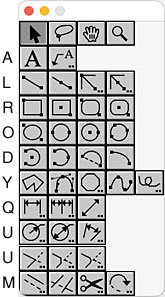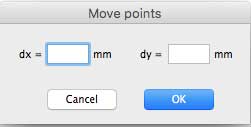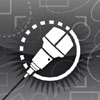| RealCADD Cursors | |
|---|---|

|
Select cursor |

|
Object is selectable |

|
Select has found an endpoint |

|
Select has found a centre |

|
Select has found an intersection |

|
Select has found a surface (periphery) |

|
Select is in parallel mode |

|
Select can draw a parallel |

|
Lasso cursor |

|
Hand cursor |

|
Zoom cursor |

|
Text entry cursor |

|
Draw cursor |

|
Draw from centre cursor |

|
Draw by diameter cursor |

|
Draw by three points cursor |

|
Draw cursor has found an end point |

|
Draw cursor has found a centre |

|
Draw cursor has found an intersection |

|
Draw cursor has found a periphery |

|
Can draw a perpendicular |

|
Can draw a tangent |

|
Lines up horizontally |

|
Lines up vertically |

|
Lines up both horizontally & vertically |

|
Rotate or symmetry cursor |

|
Rotate cursor has found an endpoint |

|
Rotate cursor has found a centre |

|
Rotate cursor has found an intersection |

|
Cutting tool is active |
Initially RealCADD will open with a new Plan – "Untitled 1" – which will be displayed at the bottom of the Window menu. As more drawings are opened, they will add to the list. To move from one to another, simply click the one you want. The current drawing will be ticked.

 The Tools pallet accesses RealCADD's drawing, operating and modifying tools. When you mouse over the pallet, it expands to show the full range of tools available. If you have "Display helptags" enabled in Preferences, hovering over a tool for a moment will display its helptag. The basic keyboard shortcut for the row of tools is shown alongside the expanded tool pallet.
The Tools pallet accesses RealCADD's drawing, operating and modifying tools. When you mouse over the pallet, it expands to show the full range of tools available. If you have "Display helptags" enabled in Preferences, hovering over a tool for a moment will display its helptag. The basic keyboard shortcut for the row of tools is shown alongside the expanded tool pallet.
To select a specific tool click the appropriate tool row on the right-hand image and then scroll down to go to the details of how it works. The red dot  indicates which selection you are on. The descriptions are based on the standard Mac Click & Drag drawing mode. If you have selected Click & Click in Preferences, then there will be minor differences.
indicates which selection you are on. The descriptions are based on the standard Mac Click & Drag drawing mode. If you have selected Click & Click in Preferences, then there will be minor differences.
Tools with .. after them can be expanded to a fuller options menu by a double-click or an ⌥-click (option-click). Once a tool that has a further options menu has been selected, you can bring up the further options by hitting the space bar – this is very handy if you want to go on using the tool but merely want to change its action in some way.
All the tools have keyboard shortcuts as shown alongside the expanded tool pallet. Multiple entering the shortcut moves you along the horizontal row. A tool remains active until another tool is selected either by clicking on its icon or hitting its keyboard shortcut.
You can choose (in Preferences >> General) to have the Tools pallet expanded all the time by unchecking the "Tools" box.
With the Line, Rectangle, Oval and Arc tools, you draw the object approximately how you want it and then edit it in the Edit and Attributes pallets to get it exactly how you want it. The Edit pallet in particular is intimately bound up with drawing using the Tools and we will discuss it here along with each tool. Refer to Window >> Attributes for more details of that pallet.
Remember also that you can access all of, or your selection of, the tools by a right-click or a ⌃-left-click (control-left-click) anywhere in the drawing. The tools that are displayed are those chosen in Preferences >> "Tools" menu ... For a tool that has further options (those marked with double-dots in the Tools pallet), ⌥-right-click (option-right-click) or ⌃-⌥-left-click (control-option-left-click) as you select the tool will bring up the further options. Once you have selected the tool, if it is one that has further options, these can be accessed by hitting the space bar.
Tip: The screen version of the Tools pallet is only available when no object is selected. A right-click with an object selected will bring up the screen version of the Action menu.
With "Command Line" you draw an object (Line, Rectangle, Oval, Arc) and set its parameters on the fly as you draw. Refer to Window >> Command line.
Snap is also an important part of controlling how objects are drawn. Refer to Window >> Snap for details of how to set Snap up.
RealCADD cursors change to indicate many important aspects of using Tools; rather than endlessly discuss these changes in each section, they are listed in the table to the far right. Those that require Snap to be active are shown in green
Tip: The Surface cursor  requires "Intersection" to be selected in the Snap pallet
requires "Intersection" to be selected in the Snap pallet
Tip: Once you have one or more RealCADD files open, they will be displayed at the bottom of the Window menu and can be selected from there to change from one to another.
 Back to top From left to right these are:
Back to top From left to right these are:
Select: Keyboard shortcut ⎋ (the Esc key).
This is the principle tool use to select objects and text. As you move over an object, the cursor will change to indicate it has found the object. At this point holding the mouse down allows you to move the object, without changing it in any way.
If Snap is active, as you move around the object, the cursor will change to indicate it has found a snap point.
Holding the mouse down over one of the object's handles (the little black squares at each end or each corner of an object) will allow you to drag that handle to modify the object in various ways – more detail in the individual drawing tools.
Holding the mouse down, clear of objects, and dragging will draw a marquee (a screen rectangle with a dashed outline) to select objects. If Snap is active, as you drag, the cursor will change to indicate that it has found, or is lined up with, various snap points. Up to Version 4.71b1, only those objects wholly contained within the marquee are selected. From Version 4.71b2, the selection mode of the marquee is controlled by the "Tool Arrow, option In/Cut" box in Preferences as follows:
Box checked. Dragging from Left to Right will select only those objects contained wholly within the marquee; the text "In" will display in the corner of the marquee. Dragging from Right to Left will select all objects that the marquee passes through, as well as those contained within it; the text "In/Cut" will display in the corner of the marquee.
Box unchecked. Drawing a marquee in either direction will only select objects wholly contained with the marquee.

Holding the mouse down with the ⌥ (option) key and dragging over an end point of a line, a corner point of a rectangle or polygon, or a node of a spline, will bring up the "Move points" pane to the right. Enter the x and/or y distances that you want to move the point/node and click OK. If you do this on an object that doesn't support the function (circles, arcs) or an area that doesn't have any points, the same pane will come up but nothing will happen when you click OK.
Lasso: Keyboard shortcut S.
When you select this tool, holding the mouse down and dragging draws a marquee around objects to be selected. Unlike the Select tool, the Lasso can draw a marquee of any shape, not just a rectangle, and it also doesn't have any Snap capabilities. So you can slide between objects to avoid those you don't want to select. As with the Select tool, it only selects objects that are wholly within the marquee.
And again, like the Select tool holding the mouse down with the ⌥ (option) key and dragging over an end point of a line, a corner point of a rectangle or polygon, or a node of a spline, will bring up the "Move points" pane.
Hand: Keyboard shortcut H.
The Hand tool is an alternative to scrolling and, holding the mouse down, moves the drawing as a whole relative to the window. Unlike scrolling, you can move in any direction, not just vertically or horizontally, which is an advantage if you basically want to scroll diagonally across the drawing.
With the ⌥ (option) key down, Hand moves the Page Break(s) relative to the drawing, leaving all the drawn objects in place and moving the page(s) relative to them, thus allowing you to print a selected part of a drawing – that is the part of the drawing inside the moved page break(s).
Zoom: Keyboard shortcut Z.
With the Zoom tool, holding the mouse down, draws a marquee; when you let go of the mouse, the drawing is magnified so that the area within the marquee occupies the screen. The Zoom percentage is shown in the zoom window bottom left on the window.
Clicking the Zoom tool once sets the zoom at 100%.
